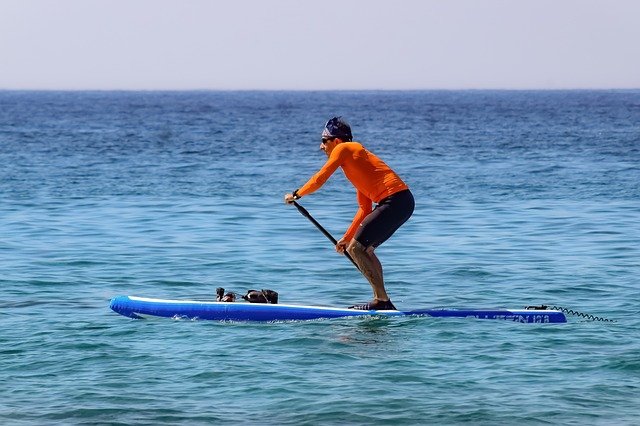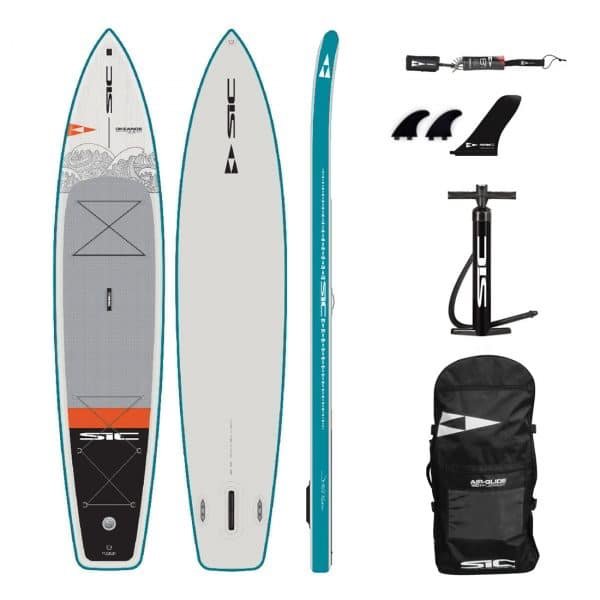Paddleboarding is famous for being blissful, but it can be easy to stress about paddleboard sizing. First-time paddleboard buyers frequently ask about SUP sizes and overall paddleboard length.
The size of paddleboard you need depends on what you want to do — yoga, race, or paddle around the lake — as well as your height, weight, and experience level. Paddleboard sizing can also vary depending on whether you’re looking at a solid or inflatable SUP.
Here’s your complete guide to finding the right SUP board for you.
In This Article
Paddleboard Sizing Basics: What Size SUP Do I Need?
Paddleboard sizing is about volume, length, width, and thickness. Here’s how we define each of these things:
Volume: The buoyancy of your board — or how much weight it can hold and still stay afloat.
Thickness: The distance between the bottom of your board — the surface that touches the water — and the top of your board, where you stand.
Width: The distance between either side of your board.
Length: The distance between the tail and the tip of your board.
When sizing paddleboards, volume comes first. A paddleboard’s volume determines how much weight it is designed to carry. While other factors can affect your paddleboard experience and sizing choice, paddleboard volume is where you need to start.
The Magic Formula
If you’re a beginner, multiply your body weight plus your expected gear load by 1.1 to 1.4. That’s the minimum weight capacity range you will want for your first SUP. Remember to account for any kids and dogs who you think will frequently come along for the ride!
If you think you’re going to be carrying more gear or going for longer paddles, shoot for a higher SUP volume. If you just want to go for quick, easy paddles around the lake, a SUP board on the lower end (a volume of 1.1 to 1.2 times your body weight) will be just fine.
Intermediate and advanced paddlers tend to go for slightly lower volume boards. Extra weight capacity provides more stability, so experienced SUP enthusiasts have already built the balance necessary to help them feel more confident on a lighter, faster board.
More seasoned individuals should multiply bodyweight and expected gear load by 1 to 1.1 to find their ideal board volume.
Length, Width, Thickness, and Paddleboard Sizes
“How long should my paddleboard be?”
“How wide should my paddleboard be?”
These are both incredibly common questions, especially after individuals learn about volume.
Overall volume is the result of the SUP board’s length, width, and thickness. If you’re just looking to quickly find a beginner paddleboard, the paddleboard’s overall volume might be all you need to know to make that first purchase.
However, length, width, and thickness can help you tailor your SUP experience for more specific goals. For instance, longer boards are better for moving quickly and are used in SUP racing. Wider boards provide more balance and are better for SUP yoga and fishing.
Shorter, wider inflatable boards are maneuverable and better for taking on whitewater or waves. Long, wide SUPs are best for fishing, as they provide awesome stability and lots of extra space for gear.
Before we get into precise measurements for specific SUP sports and activities, let’s talk about how your height and weight will impact your choice of board beyond just determining SUP volume.
Your Height, Weight, and Build
Your weight determines the volume of the board you need, but your height will determine how your weight sits on the board and how you balance your board on the water.
If you’re taller or have a more developed upper body, you have a higher center of gravity. This means you’ll probably have to work harder to maintain your balance.

There are several ways you can hone your board choice to find the perfect paddleboard for a tall person. First, you can opt for a wider or longer board. This can help you feel more stable in the water.
Alternatively, if you don’t want to radically adjust your board size choice for height (say, if you’re interested in whitewater), you can try standing further back on your board while paddling. This can help you distribute your weight more effectively and provide greater stability.
Now that we’ve covered the basics of choosing and sizing a SUP board, let’s dive into some activity-specific paddleboard sizing.
Paddleboard Sizing By Activity
We’ve already touched on some of the most common SUP activities: calm water paddling, racing, white water, fishing, and yoga. Other common SUP activities include paddleboard surfing and touring.
Easy Paddling
Go by the volume equation in the first section of this article. If you’re taller, opt for a wider, longer board, and remember to position your feet slightly further back than your shorter SUP friends. This will help you feel more balanced. A fin will help you feel more balanced and stable in the water.
Racing
For optimal speed, aim for a board that is between 10’ and 12’ long and 31” and 32” wide.
Opt for a paddleboard with a sturdy, aggressive fin–unless you’re anticipating rocky, shallow water–as this will help your board stay straight. This will help you travel more quickly and efficiently.
Touring
If you want to go for long trips–perhaps even trips that span several days–you’ll want a stable, quick-moving SUP. Remember to account for gear weight when factoring volume.
Boards between 11’ and 13′ 2″ in length and 31” to 34” wide tend to work best. With some careful consideration, you may find a board that works great for both racing and touring.

Whitewater
Turning radius matters in whitewater. When riding the river’s hydraulics, there is often very little space between one “wave” and another. This means you’ll want a shorter, more maneuverable board.
Look for an inflatable SUP that’s 6’-8’ in length and around 30”-34” wide. Pay attention to the rocker curve: you want a board with an upward curving nose that helps you transition quickly between waves. You’ll want to leave the longer fins at home when taking on whitewater!
River Running
Maybe you’re not quite in whitewater territory but still want to travel down a quick-moving river and paddle creeks or streams. If this is the case, a river running SUP is probably perfect for you.
11’3” long and 30”-36” wide inflatable SUPs are standard for this activity. Opt for flexible, removable fins–just in case you venture into shallower, rockier territory.
Fishing and Yoga
If you’re interested in heading out on calmer waters to see what fish you can catch, you’ll want a board that can accommodate your gear, as well as snacks and beverages. Testing your balance in paddleboard yoga will also necessitate a long, sturdy board.
Wide, long, thick boards will provide you with great stability and comfort for both yoga and fishing. 33” to 36” wide and 10’6” to 12’ long SUP boards work best.
Surfing
Surf’s up for SUP! Riding ocean waves is an unparalleled thrill and requires agility and quick thinking. For these reasons, a shorter board–slightly longer than a white water board–tends to be best.
Depending on your height and weight, go for a board that’s between 29” and 32” wide and 9’ to 11’ long.
Wrapping Up
Paddleboard sizing depends on a variety of factors. Your weight is the biggest factor in determining the necessary paddleboard volume, but finding your perfect SUP doesn’t stop there. Your height and center of gravity will play a factor in what SUP you paddle as well as where you stand on your board. For these reasons, never be afraid to take a class or ask for help when learning to SUP.
Your activity of choice is also critical in helping you decide what board is best for you. Regardless of your experience level or preferred paddleboard activity, we hope you enjoy the relaxation and the excitement that comes from SUP.


This is indeed a really good guide, thanks for sharing I hope I had this one before I smash into the water 😉